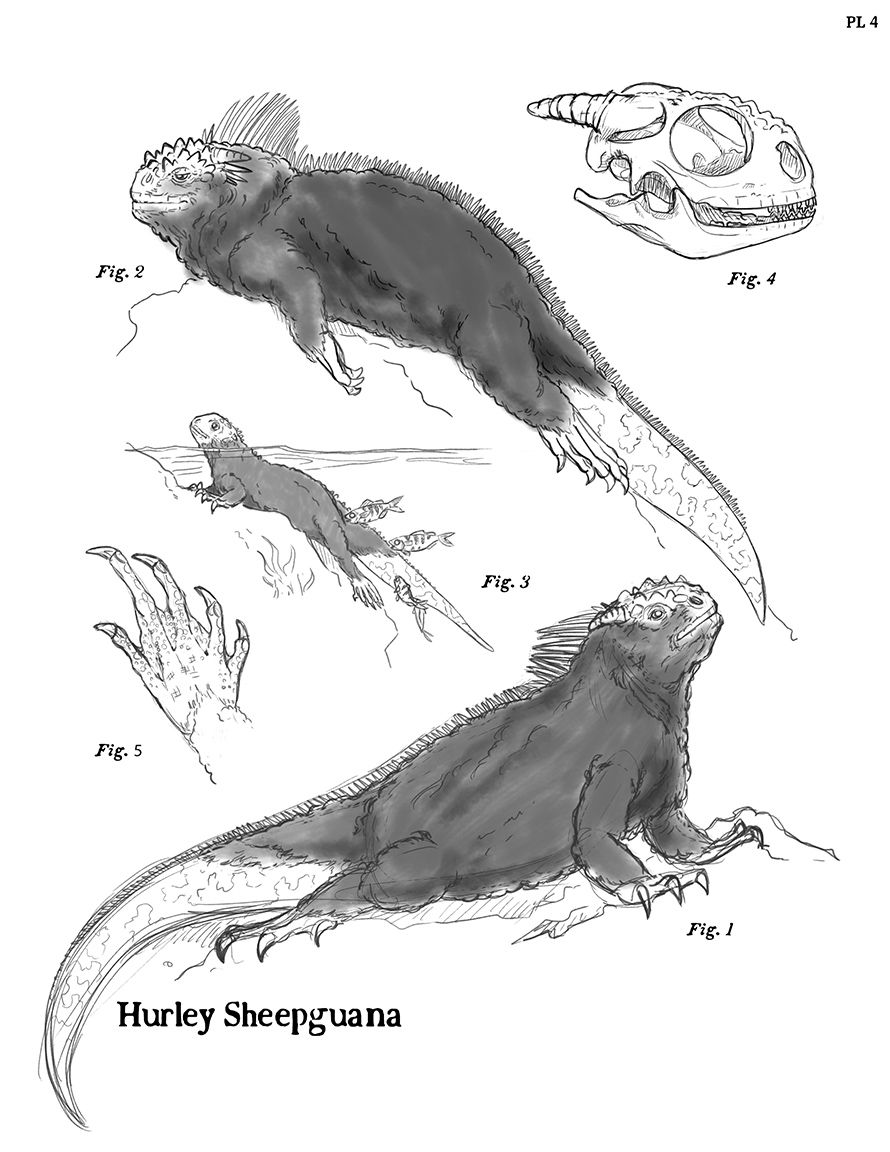
- Fig. 1: Adult Eweguana, crawling on land
- Fig. 2: Adult Ramguana, basking
- Fig. 3: Lambguana, being groomed by Azurina eupalama
- Fig. 4: Skull
- Fig. 5: Right rear foot, showing webbing
The nigh infinite adaptability of the sheepguana to almost any conceivable surroundings is second only to the good natured cheerfulness with which they endure them. One breed that is an excellent example of the former quality while entirely lacking the latter are the Hurley sheepguana tended by the merfolk.
Their ancestors were infamously sold to the last Queen Beneath The Storms by a ruthless merchant as “fire starters that will kindle flame even in the wettest of conditions”. This is true insofar as a sheepguana can indeed breathe fire whenever it pleases, but still seemed to be of limited use to the merfolk, who own no lands above the surface save a few rocky islands and some stretches of coastline too sandy and shallow for fishing boats and too infertile for anyone else to want. It seemed clear to everyone involved that the animals would inevitably either drown or starve to death, including the merchant, who had received payment in advance and was absent, as well as the poor clueless guardian who had been tasked with delivering them and familiarizing the unspecified new owners with their care. Yet while the merfolk delegation were arguing over whether to try to get their money back or to cut their losses and have a feast, and the guardian was becoming increasingly anxious about the dark outlook for her flock and the frequent suggestion of sending her body parts to the merchant to encourage a refund, the sheepguana had followed the receding tide and wandered into the exposed mudflats to calmly munch on algae and seaweed. Upon seeing her charges fill their stomachs while the lambs were playing in the surf, the guardian sent a relieved prayer to the Lady of the Flocks and went to convince her new bosses to give her a chance to develop the breed that now bears her name.
The typical Hurley sheepguana has a compact, stout body for heat retention with a wide tail for propulsion and relatively short legs with sturdy claws for climbing over rocks. Their wool covers most of their bodies save the tail, the feet and the tip of the snout and when it is not flecked with dried salt, it is of a deep black that seems to reach out to devour the light. This unique colour as well as its ability to repel fire and water alike make it much sought after by wizards, adventurers and other people rich enough to afford it or reckless enough to need it. Under water, the fleece will trap a layer of air around the body that provides both insulation and buoyancy. The Hurleys increase this effect by breathing a slow, soft flame and directing the hot air into their wool, charging it up with heat against the icy waters. In the cold months, one can often see the shores of their pastures dotted with pairs of sheepguana with their noses buried in each others fleece warding each other against the cold. To preserve this effect, Hurleys cannot be shorn as closely as other breeds, which contributes to the high price their wool commands.
Besides their traditional use in producing wool, milk and meat, the Hurley sheepguana have also more than fulfilled the role for which they were originally acquired, lending their innate mastery of fire to the grateful merfolk. Beyond just lighting the fuel in their forges, some sheepguana are fed a special diet optimized to produce flammable gasses and will sustain, modulate and guide their flame to the direction of a smith. This manifold increase in their ability to work metal has increased the merfolk’s ability to protect themselves from the monsters of the deep as well as the general standard of living to the point where many began to question the necessity of the old feudal system. Eventually the allied guilds of metalworkers and shepguanherds launched a revolution to establish a state aimed at the welfare and equality of all citizens. Resistance from the aristocracy was scattered and collapsed entirely when the Queen Beneath The Storms abdicated her throne to take up glass blowing. Today the Workers’ Republic Beneath The Storms is a loose federation of local communities, most of which are organised similarly to a herd of sheepguana. They are admired and envied for their art, scolarship and general prosperity by the land kingdoms, where owning any of their texts on political philosophy is punishable by death.
Though it started out picking through the shallows, time and careful breeding have turned the Hurley into an excellent and confident swimmer and adults and adolescents will follow their guardian well out of sight of land to reach fertile grazing grounds while younger lambs will stay closer to shore protected by their mothers. If they do not use air for breathing fire, adult animals can stay underwater for close to fifteen minutes during which they will anchor themselves to the ground with their claws to graze. Landbirds are advised to keep a respectful distance from grazing flocks, as ramguana are often aggressive towards boats and any fishing net that snares a sheepguana will be reduced to smouldering shreds, which the indignant guardian will usually return with a stern warning against further trespass.
In studying their behaviour one might, in fact, get the impression that even generations later and despite prospering beyond expectations, the Hurley sheepguana still bear a grudge against all land dwellers. Travelling bards often describe them resting in the sand, glaring at a passing caravan, gently steaming with evaporating seawater and resentment. This impression is most famously depicted in Sayrah Avecthé’s painting “Ornery Beach Sheepguana”.
Inspired by this tweet:

